Here’s the full list of Abraham Hicks processes from the book Ask And It Is Given. Each of the processes below are designed to help you get into the vortex so you can manifest your desires, based on wherever you are on the emotional scale.
I have my go-to processes, depending on how I’m feeling in the moment, and what I’m working on. But if you’re not sure where to begin, take a look at the Abraham Hicks emotional guidance scale first, to identify your current emotional set-point.
Then, you can focus on the processes that will work best for how you’re feeling.
It’s so important to have the right tools and practices to soothe you back into alignment.
As you probably already know, law of attraction is going to deliver you experiences that match your dominant feelings and thoughts.
That’s why it’s so important to make a conscious decision to feel the best you can, everyday: to get into the vortex, as Abraham would say!
Quick Note: You can get this book for FREE when you sign up for a free trial of Audible.
Audible is Amazon’s audiobook store:
I can’t wait for you to try out some of these processes and hear which ones are your favorite!
- Rampage of Appreciation
- Magical Creation Box
- Creative Workshop
- Virtual Reality
- Prosperity Game (Checkbook Game)
- Process of Meditation
- Evaluating Dreams
- Book of Positive Aspects
- Scripting
- Place Mat Process
- Segment Intending
- Wouldn’t It Be Nice If…
- Which Thought Feels Better?
- Clearing Clutter for Clarity
- Wallet Process
- Pivoting
- Focus Wheel Process
- Finding the Feeling-Place
- Find The Feeling-Place Example
- Releasing Resistance to Become Free of Debt
- Turning It Over to the Manager
- Reclaiming One’s Natural State of Health
- Moving Up the Emotional Scale
- Conclusion
Rampage of Appreciation
Emotional Set-Point: 1-5
When To Do It: When you’re already feeling good, and want to feel even better. Or, if you’re feeling good but sense negativity creeping into your experience. Think of this Abraham Hicks process as preventative maintenance for your mood!
Start by looking around and picking one thing to focus on, and place all your attention on appreciating it. It can be anything from a bouquet of flowers, to your favorite chair, or the weather outside.
Then, start listing off (in your mind or on paper) things you appreciate about that thing, then another, and then another. After just 17 seconds or so, law of attraction will start bringing you even more appreciative thoughts on the same subject.
Keep the momentum going for as long as it feels fun, up to 15 minutes. You’ll be amazed how your mind expands to find countless things to enjoy.
Hicks suggests doing this one every day for a few minutes, provided you’re somewhere between optimism and joy on the emotional guidance scale.
Rampage of Appreciation Example
Let’s take grocery shopping as an example. Here are some things you might notice as you do your shopping:
- Everything looks so clean
- Look at this beautiful abundance of food
- I’m so blessed to have access to such a variety of products
- This shopping card makes gathering my things so convenient
- The air in here is nice and cool (or warm)
- I really appreciate all the work the employees do to stock these shelves
- It’s so nice to prepare myself for the week by filling my home with delicious things to eat.
- I look forward to turning these groceries into beautiful, nourishing meals
- That check-out person is doing such a great job
- Everyone here seems to be having a pleasant experience
- It’s so nice to stimulate the economy by spending my money on things that will serve me
- I love the music they’re playing
- I enjoy being part of this community
Who knew there was so much to enjoy with a simple trip to the store! When you use the rampage of appreciation process, you’ll be feeling high on life!
Magical Creation Box
Emotional Set-Point: 1-5
When To Do It: When you’re in the mood to take creative action toward manifesting a specific desire.
Making a creation box, otherwise known as a manifestation box is one of my favorite ways to manifest. All you need to do is find (or make) a box, and fill it with things that remind you of your desire.
So you can clip things out of magazines, toss in notes to the universe or affirmations, and anything else that represents something you want to bring into your life.
Abraham suggests writing this statement someplace on or in your creation box:
“Whatever goes in this box – IS!”
Don’t you just the power of that statement? This process is ongoing, until you attain whatever it is you’re focused on. So as you go about your days, and you see something that adds detail to your vision, write it down and toss it in your creation box.
The beauty of this process is that it helps you to enjoy the entire process of turning thoughts to things. After all, manifesting your desires should be fun!
I prefer to focus on one desire at a time, but do whatever feels right to you.
Example of Creation Box
I’m currently working on manifesting my dream backyard. Here are some things going into my creation box:
- A drawing of my desired layout
- Magazine cut-outs of beautiful outdoor spaces
- Images of people gathered by a fire
- A piece of jade to attract prosperity
- Samples of tile and stone
- A pair of sunglasses for fun in the sun
- A packet of seeds for planting flowers
- Pictures of an outdoor dining table filled with food and drinks
- A list of emotions my space will evoke: relaxation, tranquility, fun, comfort, luxury, joy
The sky’s the limit with this game, so don’t play it small!
For more on creation boxes, read this next: Best Manifestation Box Ideas To Make Your Dreams Reality
Creative Workshop
Emotional Set-Point: 1-5
When To Do It: When you need help determining which desires you’d like to focus on next.
Here are the basic steps involved:
1) Get 4 pieces of paper and label them: “My Body”, “My Home”, “My Relationships”, ‘My Work”.
2) For each paper write 0-3 things off the top of your head that you’d like to manifest in that area of your life, leaving plenty of space between each item.
3) For each thing that you want, tack on a few reasons why you want it.
This process builds positive momentum behind your desires, and helps you determine which ones are really lighting you up in the moment.
Step 3 is especially important because so often we say “I want this but…” and start listing all the reasons why we think we can’t it. When law of attraction gets ahold of statements like this, it moves you further away from your desire.
But if you instead say “I want this because…” you’re focusing on all the good things about your desire.
Example of Creative Workshop
Here’s a picture of my creative workshop ideas! My relationships are great in this chapter of my life, so I left that blank. I have two desires for my body and one each for work and home.
Now I can focus in on one or two of these at a time, and even apply the other processes to them (like a manifestation box or focus wheel).
What are some of your goals? Leave me a comment!
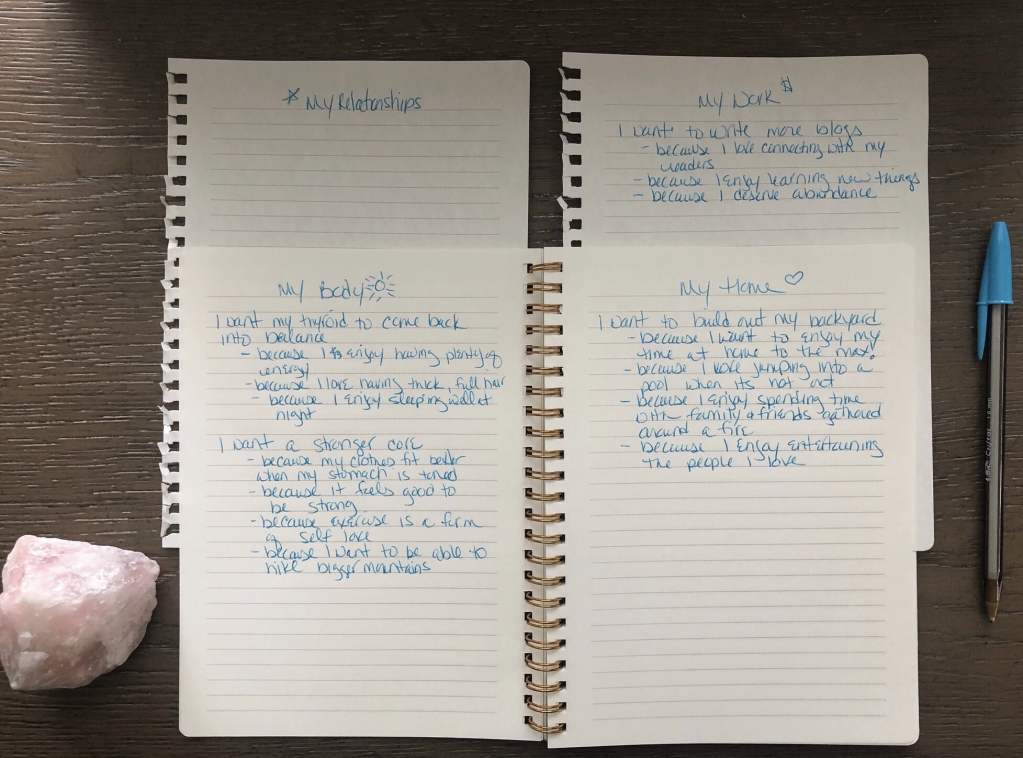
Virtual Reality
Emotional Set-Point: 1-8
When To Do It: When you want to practice allowing, so that you can attract even more good things into your life.
The Virtual reality process is really just a happy daydream. This is something you should do when you’re already feeling pretty good, and want a quick activity to raise your vibration.
The most noteworthy criteria about this game is that it’s not to fix anything that’s broken. Abraham explains that if you try to do this to improve something, you’ll end up dragging your low vibes into the visualization, which will defeat the purpose.
All you need to do is imagine a scenario that brings you joy! Your visualization won’t necessarily about of something you’re try to manifesting. This is more about becoming practiced at improving your mood on demand, for those times you feel yourself slipping into lower emotions that don’t serve you.
Ask yourself questions like these to build out your happy place in your mind:
- Where am I?
- Am I outside or inside?
- Is anyone with me? (don’t include anyone who gives you split energy)
- What am I doing?
- What can I feel, smell, see, hear, taste, or touch?
The goal of this exercise is to build a happy scene, experience the joy it brings, and then hop out. This is because if you linger in your virtual reality for more than a few minutes, your practical mind will get ahold of it and start adding displeasing details.
The virtual reality exercise is only meant to offer you a few minutes of sweetness in your day.
Example of Creation Box
Here’s one of my virtual realities that always brings me comfort:
I’m in my home, having a visit with my (now deceased) cat. She’s curled up in my arms, purring. I can feel her soft fur and the warmth of the fireplace as we sit under a blanket, resting. I tell her I love her, and I can sense her love in return.
That’s it! I stayed in that space for just about a minute and then got out. There’s no time for my mind to wander to anything else.
Also, I have no resistance at all toward the subject of my cat having died. If I were still healing, I would not have chosen this scene because it would have lowered my emotional setpoint, instead of raising it, which is the whole point.
You can read more about creation boxes here: Best Manifestation Box Ideas To Make Your Dreams Reality
Prosperity Game (Checkbook Game)
Emotional Set-Point: 1-16
When To Do It: When you’re focused on manifesting financial abundance over the long term. Also to strengthen your imagination skills.
The Abraham Hicks checkbook game focuses on manifesting money. You’re going to create a ledger, similar to what you use to balance a checkbook. Also, you’re going to be writing out imaginary checks to spend that virtual money.
Here’s how it works: On day one, deposit $1000 into your imaginary checking account. Then write out an imaginary check (or checks) to spend it.
On day two deposit $2000, on day 4, $3000, and so on. By the end of one year, you’ll have deposited $66 million! Do you think you can spend all that, even in your imagination? This exercise really challenges you to think bigger where finances are concerned.
Here are some ways to spend your imaginary dollars:
- Big ticket items like a new home or car
- Vacation and travel
- Giving it away to loved ones
- Charity
- Investing in the stock market to grow your dollars
Example of the Prosperity Game
I did my ledger in Excel but you can track your deposits on paper, too.
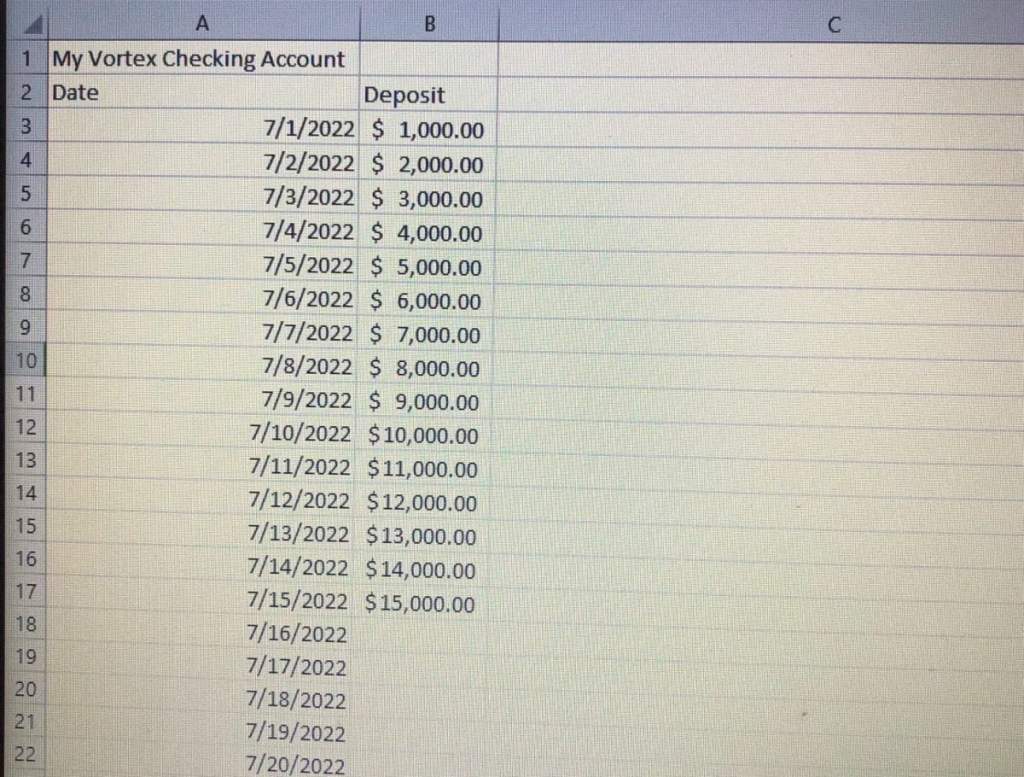
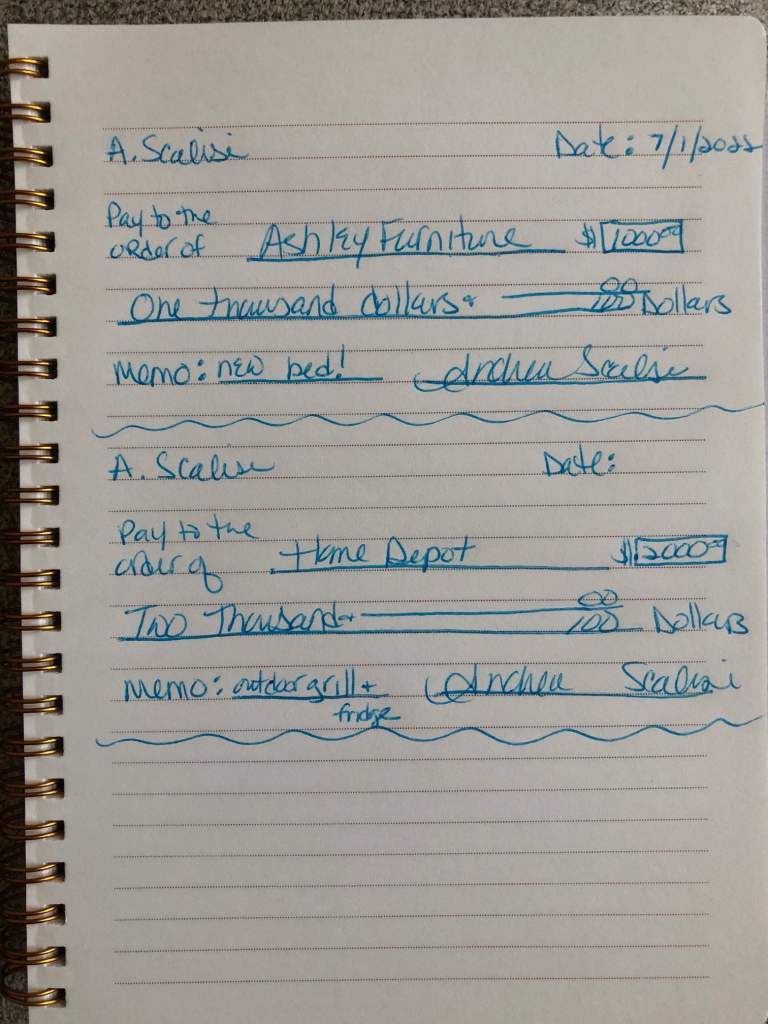
Process of Meditation
Emotional Set-Point: 1-22
When To Do It: Anytime you want to raise your vibration, let go of resistance, or feel more connected to your Source. Abraham recommends that you meditate daily!
The basic point of meditation is to suspend your thoughts. Thoughts that you think over and over again form your beliefs. When you have a belief that doesn’t serve you, it makes it harder for you to manifest.
On top of this, your beliefs have strong momentum behind them, so it makes it a challenge to redirect your thoughts away from them. As you know, law of attraction brings you more of what you think about most – so its very important to give your negative thoughts a rest, so you can manifest your upgrades.
That’s why clearing your mind is so beneficial – sometimes it’s actually easier to think about nothing at all, than thinking positively about subjects you have a lot of resistance on.
Example of Meditation:
Throw on some comfy clothes and find a place to sit where you’ll be undisturbed for about 15 minutes or so. You may want to set your timer so your mind doesn’t get distracted about how much time has passed.
Close your eyes, and just focus on your inhales and exhales. If thoughts creep in, which they will, just gently redirect your attention back to your breath.
Or if you prefer a guided meditation, you can try this 5 minute Body Scan Meditation to Ground Your Energy
Evaluating Dreams
Emotional Set-Point: 1-22
When To Do It: To gain insights into the reason for a particular dream, or to get an idea of what your in the process of manifesting.
Your dreams are always a match what what you’ve been thinking and feeling while you’re awake. So really, your dreams are your own creations, and are early signs of what you’re manifesting.
Before you fall asleep, affirm: “I intend to rest well and wake up refreshed. And, if there’s something important I need to remember from my dreams, I’ll recall it when I wake up”.
Then, when you awaken, notice what you can remember. The details of the dream aren’t as important as how the dream made you feel.
If your dreams conjured positive emotions, then you’re right on track! Or, if your dreams bring up negativity, then that’s your signal to choose thoughts and activities that feel better as you go about your day. Bad dreams are just a loving signal that you have an opportunity to make upgrades in your life.
To read more about dreams, dream control, and dream recall, read this next: 40+ Lucid Dream Affirmations To Stimulate Your Subconscious Mind
Book of Positive Aspects
Emotional Set-Point: 1-10
When To Do It: When you’re feeling great about a particular subject and want to milk it. Or, when you’ve been focused on something that doesn’t feel good that you want to change your perspective on
First, find a notebook that you can dedicate to this process, preferably one you find pleasing to the eye. On the cover, label it ‘My Book of Positive Aspects’.
On the first page of your notebook, write the name of someone or something that you ALWAYS feel good about. Maybe it’s a furry or feathered companion, or your favorite room of the house. Anything that’s easy to feel good about will work.
Then, start writing down things you appreciate about the object of your attention. Just let them flow for about 20 minutes or so.
Now repeat this process for a second time for a different person, place, or thing. Notice how much easier it is the second time around to think of reasons why you love and appreciate whatever you’re focused on.
This is because law of attraction is in on the game, bringing you more ideas and thoughts that are similar in vibration to the ones you’ve been thinking. This exercise is such a powerful demonstration of how the process of manifestation works!
Book of Positive Aspects Example
Here’s one I started for my home. What would you choose? Leave me a comment below!
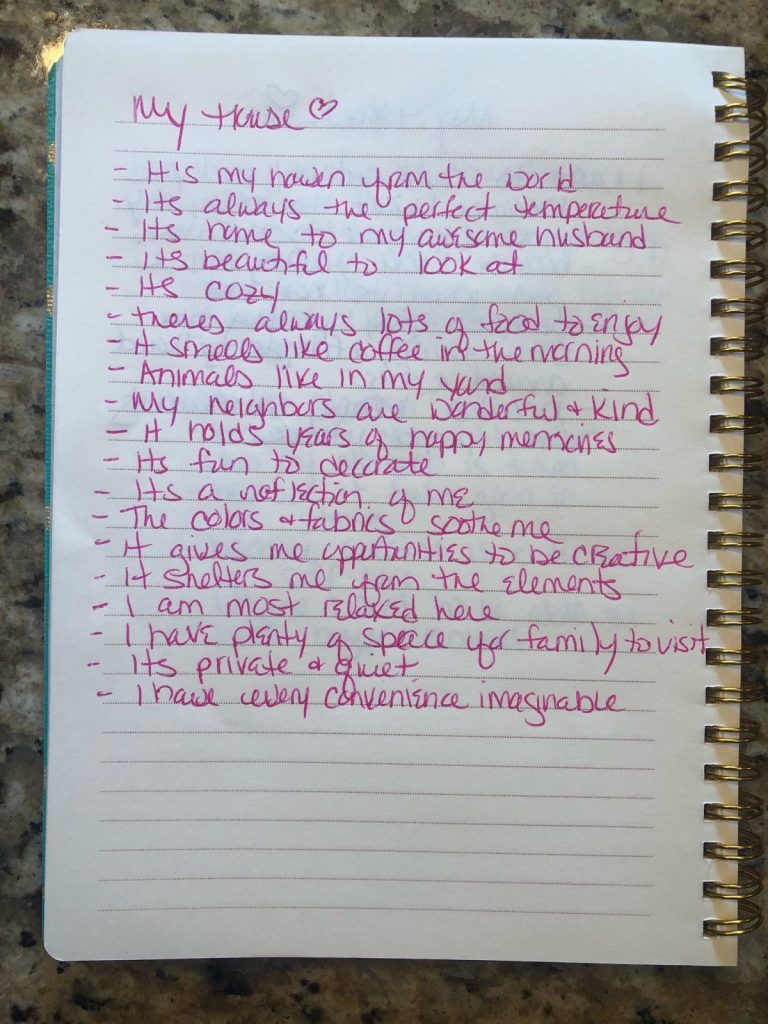
Scripting
Emotional Set-Point: 2-6
When To Do It: When you’re feeling excited about something specific and want to add detail to your vision.
The basic premise is, imagine you’re writing a book, and everything you write down happens, just the way you say. This game encourages you to focus and eliminates resistance. It’s so fun!
So choose your one topic, grab some paper and imagine your perfect unfolding, in as much detail as you can. Write it all down as if you’re writing a story. This process helps you to get super clear on exactly what you want; and of course the universe is listening!
Examples of Scripting
I have a whole separate post that goes into the details of scripting and shares examples. You can find them here: How To Use Scripting To Manifest Your Happy Future
Place Mat Process
Emotional Set-Point: 2-11
When To Do It: When you feel like there’s a bit too much on your plate.
It’s easy to get caught up in the idea that everything requires ‘action’, and forget about how important your energetic vibration is. When your vibe is high, law of attraction is working in your favor, and things flow to you with more ease. The place mat process can help you get into this space.
First, grab a piece of paper and draw line down the middle. Label the left side “Things I’ll Do Today” and the right side “Things I’d Like The Universe To Do Today”
On your side of the list, only write down the bare essentials that you need to get done that day. Then put everything else on the Universe’s side.
Notice how much lighter you feel at this point! This process helps you to practice the art of allowing. Check back in at the end of the day and see how many issues have resolved themselves in the coming days, or become lower priority.
Example of Placement Process
You guys, I swear to God, while I was writing this list my father-in-law texted to say he could come pick up the keys I was supposed to drop off AND my mom texted, inviting me to dinner.
You can’t make this stuff up!
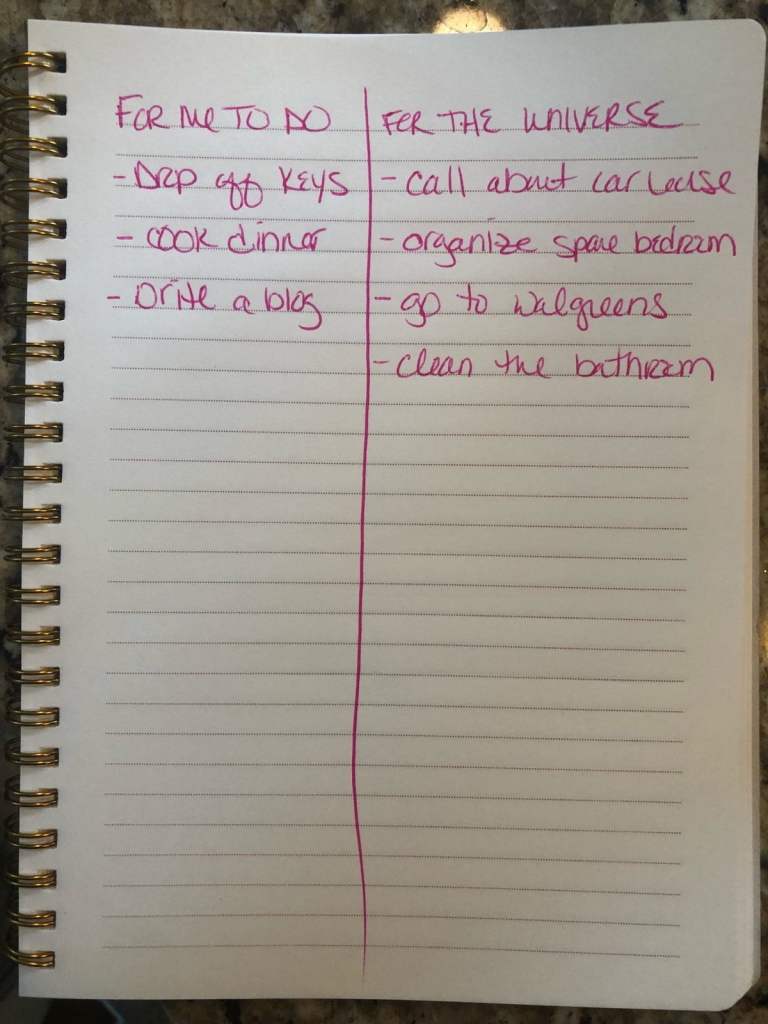
I think it’s hilarious that the universe cleaned up my side of the list lol – apparently it didn’t want to clean toilets! But all in all, the process served its purpose, because now I’m freed up to do some of the other tasks.
It also made me realize, there’s no reason I need to do some of these things today – they can wait, and I can relax. A little bit of surrender goes a long way.
Segment Intending
Emotional Set-Point: 4-11
When To Do It: When you want to set clear intentions for how a certain part of your day will unfold – especially if you know there’s a chance things could go either way.
You may have heard Abraham talk about ‘getting out ahead of it’. This is the essence of segment intending. A segment is just a block of time in your day. So getting ready for work in the morning is a segment, driving in your car is another, your lunchbreak is another, and so on.
When you take a few moments to set intentions for the next segment of your day to unfold in a positive way, you’re focusing that positive outcome into being.
Example of Segment Intending
When I wake up in the morning, before getting out of bed, my thoughts go something like this:
I fully intend to have a wonderful morning. I can’t wait to open the drapes and see what kind of weather we’re having. Maybe I’ll even see some turkey or deer in the yard.
Then I’m going to enjoy a warm, soothing washcloth on my face. I love that feeling in the morning. The coffee smells delicious and I can’t wait to have a cup. After I’m showered and dressed, I’m going to settle into my office and have a super productive morning. This is the best day!
This may sound like I’m pouring it on but I swear these are my sincere feelings when I start each day (90% of the time). Feeling good is a practice! And it eventually becomes a habit that comes naturally.
Wouldn’t It Be Nice If…
Emotional Set-Point: 4-16
When To Do It: When you feel negativity start slipping into your thoughts or conversation, and you want to turn it around before it gains momentum.
So if you catch yourself feeling impatient, or complaining about what is, instead of what you want, this is an excellent process to try.
All you need to is say “wouldn’t it be nice if…” and fill in the blank with whatever your desire is. This is so easy to do and it’s a powerful way to pivot from worrying and doubt to enthusiasm and hope.
Wouldn’t It Be Nice Example
As I’ve mentioned already, I’m currently working on manifesting my backyard buildout. 99% of the time I feel great about this subject and my desire feels good. But once in a while when I start adding up the costs, I start worrying about having enough money.
So to get move myself out of that limiting mindset, I’ll say things like:
- Wouldn’t it be nice if a big chunk of cash unexpectedly fell into my lap?
- Wouldn’t it be nice if this ended up costing less than I’m expecting?
- Wouldn’t it be nice if the universe were to send me creative, helpful people with fresh ideas on how to achieve my vision?
If you’re working on manifesting more money, I strongly recommend you read this next: 7 Best Money Affirmations (and how to get fast results)
Which Thought Feels Better?
Emotional Set-Point: 4-17
When To Do It: When you need help making a decision, or when you experience negative emotion and want to shift your perspective.
As you’ve probably hear Abraham say, every subject is really two subjects. In other words, there are two ends to every stick.
You can either focus on what you want (which will attract your desire to you), or your can focus on the absence of that thing (which will keep you apart from your desire). The Which Thought Feels Better process will help you to recognize when your focused on the right end of the stick, so to speak.
This is a game best played alone, since other people’s opinions can muck up your own emotional guidance.
This is how it works:
Grab a piece of paper and write a sentence that reflects how you feel about the subject in this moment. It’ll probably be negative, and that’s okay – that’s why we’re playing this game.
Then, write a second sentence (and a third, if you want) that amplifies how you feel even more strongly – that’s right, get dramatic! This’ll really help you see your improvement as you move along in this process.
One quick word of warning, this part of the exercise feels great when you’re annoyed because it’s a nice way to vent! But don’t get too carried away – you don’t want to build momentum around your negative thoughts.
Now write “I’m going to reach for better feeling thoughts on this subject now.”
Then start writing new sentences, and one by one, evaluate if they feel better, worse, or the same as your original statement. When you’re more easily finding better feeling thoughts, you can stop and pat yourself on the back!
Example of Which Thought Feels Better
Let’s say someone was rude to you. You might start with something like:
That was so rude of them to say and I did nothing to deserve it. What a jerk he is! He has no concern for other people’s feeling at all. He only cares about himself and has no spiritual awareness whatsoever.
Now I’m going to reach for some better feeling thoughts on this subject.
- That guy is a complete jackass (worse – oops!)
- He’s not a very kind person. (same)
- He wasn’t being very kind in that moment. (better)
- Maybe he was just having a bad day. (better)
- I hate it when a grumpy person lowers my vibration. (worse)
- Actually, I’m responsible for my own mood. (better)
- I create my own reality (better)
- This was a good reminder that I can choose to focus on things that make me happy, even if those around me are choosing to be negative. (better)
- Who knows what he’s experienced in life (better)
- I’m going to let him off the hook and tend to my own vibration (better)
Clearing Clutter for Clarity
Emotional Set-Point: 4-17
When To Do It: When you feel stressed out, frazzled, or disorganized.
For this game, you’ll need 20 or so stackable cardboard boxes of similar size and shape. You’re going to number the boxes 1-20.
Then ask yourself,
Is this item necessary to my immediate experience?
If the answer is yes, leave it. Or, if the answer is no, stick it one of the boxes. Repeat this process as you look around the room, placing similar items together in one of the boxes.
So you may end up with a box of old clothes, another box of electronic gadgets you no longer use, another box of old papers, etc.
The beauty of this game is that you can stack up the boxes and just leave them be when you’re done. Let a few weeks go by. Did you miss anything? If not, toss that stuff!
Wallet Process
Emotional Set-Point: 6-16
When To Do It: To attract more money into your experience.
This is one is fun! Get yourself a $100 bill and put it in your wallet/purse. Carry it with you everywhere you go. Then, every time you’re out and about, think of all the things you could buy with that bill (without actually spending it).
Do this a couple dozen times per day as you pass by shop windows, browse online, go out to eat and scan the wine list, etc. As you imagine yourself spending, your vibration about money will rise, which makes you an abundance magnet!
Pivoting
Emotional Set-Point: 8-17
When To Do It: When you notice your point of attraction could be improved on a topic.
This process is all about letting what you don’t want fuel your desire for what you do want. Pivoting is something you do in your thoughts, when you catch yourself focusing strongly on something that isn’t pleasing to you.
Mental pivoting helps you gradually shift your point of attraction, by refocusing your attention toward what you want, and away from what you’re missing.
Example of Pivoting
Let’s say you’re feeling unwell. I know when I’m sick I find it almost impossible not to focus on how poorly my body is feeling. That’s just human nature! But next time, try prompting yourself with a question like this:
This dis-ease in my body is making it very clear what I don’t want. What would I prefer instead?
And then let your mind wander to thoughts like,
- I really want to feel good in my body
- I want to awaken feeling energetic and clear minded
- I want the my body to self-heal while I sleep
After a few statements like this, law of attraction will bring you upgraded thoughts to match. Such as:
- Most of the time I do feel well
- This downtime is helping me to slow down and refocus on what’s important
- I know my body is a powerful healing machine
- Wellness is my natural state that I will always return to
- I’m beginning to feel better already.
- I’m going to love myself through this and pamper my body.
Focus Wheel Process
Emotional Set-Point: 8-17
When To Do It: When you’re feeling negative emotion and want to rally better feeling thoughts
A focus wheel is the perfect exercise when you’re struggling to manifest something because you can’t see past your current circumstances. After all, it’s hard to look at something unwanted and keep your outlook positive.
A focus wheel helps you change your thought patterns on a subject, so you can manifest your upgraded experience. At the end of the process, you’ll end up with a drawing of a large wheel that holds statements that get increasingly more positive as you go along.
I share step-by-step instructions here: How To Make A Focus Wheel For Manifesting
Finding the Feeling-Place
Emotional Set-Point: 9-17
When To Do It: When you want to improve an existing situation.
This is really just visualization. So, often when we want something and someone asks us why, we’ll start explaining what’s wrong with our current situation. When you do this, you’re strengthening the vibration of what you don’t want. Not good!
Instead, you want to focus on all the wonderful reasons why you want to shift into something new. You can do this by tapping into the emotions that you’ll feel when your desire comes to fruition.
That’s what the ‘feeling place’ is referring to: imagining how it’ll feel for you to get what you want. When you do this, you become a perfect vibrational match to your desire.
Find The Feeling-Place Example
So back to my backyard buildout example. I’ve totally caught myself explaining why I want this in a way that doesn’t support my desire.
For example, I’d say things like:
“I need more ways to cool down in the backyard. It’s always so hot and uncomfortable out there. I can’t enjoy my own backyard because there’s nothing to do in it.“
Yuck! Those statements conjure negative emotion, and that’s my signal that I’m vibing in opposition to my desire.
Instead, I might say something like this (notice all the ‘feeling’ words):
“I really love the idea of having a sweet little pool I can hop into whenever it’s hot, and a gorgeous grill that I can use to cook delicious meals outside. It’ll feel so luxurious and relaxing.
There is so much space to work with out here, that the sky’s the limit to what I can create. I can already feel how peaceful, refreshing, and fun it’ll be to spend time in my beautiful outdoor space.”
Releasing Resistance to Become Free of Debt
Emotional Set-Point: 10-22
When To Do It: When you’re focused on becoming debt-free.
Grab that notebook and create a column on a page for each expense you have. Start on the left, labeling each column, starting with your biggest expense, down to your smallest.
For each column, write down the minimum monthly payment required, and underneath that, the total outstanding debt for that item.
Across the top of the page write these words, or something similar:
It is my desire to keep my promise regarding all these financial obligations, and in some cases I will even do twice as much as is required.
Every time you pay a bill, adjust your ledger to show the reduced outstanding outstanding.
Whenever you can, double your payment on the item at far right of your page (the one with the lowest amount). Soon, you’ll knock that one right off the page by paying it off quicker.
This feels so good and actually makes a game out of paying your bills!
Turning It Over to the Manager
Emotional Set-Point: 10-17
When To Do It: When you feel overwhelmed, over as if don’t have enough time to get everything done.
This is a mental exercise that reminds you of law of attraction’s role in your life. It goes like this:
Imagine you’re the owner of a large company, with several departments and hundreds of employees. Instead of trying to meet everyone’s needs and keep their goals on track, you have a manager that you can deal with directly. You can tell this competent, responsible person everything that you want, and they’ll run with it and make sure it happens.
Law of attraction is that manager in your life.
You don’t need be the only one doing the heavy lifting in every situation. Surrender, ask the universe to take on a larger role, and expect positive results (that’s the key). When you do this, life becomes so much easier, my friend.
Reclaiming One’s Natural State of Health
Emotional Set-Point: 10-22
When To Do It: When you’re sick, in pain, or have any fears about your physical body.
You’ll need your notebook again for this exercise – you’ll be writing down some positive statements, then reviewing them as you lie down and rest.
Here are some examples Abraham provides in the book. But you should feel free to make up your own, too, but just notice how they progress, and gently soothe you into a place of ease:
- It’s natural for my body to be well
- Even if I don’t know what to do in order to get better, my body does.
- I have trillions of cells with individual Consciousness, and they know how to achieve their individual balance
- When this condition began, I didn’t know what I know now.
- If I had known then what I know now, this condition couldn’t have gotten started.
- I don’t need to understand the cause of this illness.
- I only have to gently , eventually release this illness
- There’s no hurry about any of this.
- I’m in very good hands
- I will relax now, to allow communication between my body and my Source
- My only work is to relax and breathe
Moving Up the Emotional Scale
Emotional Set-Point: 17-22
When To Do It: When you’re feeling frightened, sad, or upset.
This exercise helps you remember there are no outside forces of evil forcing their way into your life. Instead, there are just different levels of allowing the goodness.
The goal is to prove this to yourself by deliberately changing your emotional state. Start by identifying what your current emotion is on the emotional guidance scale.
Then, reach for thoughts that feel ever so slightly better than you’re feeling in the moment. Remember, there are no big leaps when you’re climbing the emotional ladder. Be patient with yourself as you gently find words that resonate with the next emotion up on the scale, and then the next, and the next. Repeat this until you find relief.
It’s okay if you don’t make it to the top of the emotional scale. In fact, most of the time you won’t, if you’re working through grief or major challenges. But it is realistic to climb one or two rungs on the emotional ladder and that will feel like a very welcomed improvement.
Conclusion
With all of these options, there is always a process you can turn to, in order to find your way back into the vortex!
All of these games are designed to help you let go of resistance and allow the wellbeing that you so very much deserve, which is really step 2 of the 5 step process for getting into alignment. So I strongly suggest you read this next, to get the full picture of Abraham’s teachings: The 5 Abraham Hicks Steps To Align Yourself Now
Which Abraham Hicks processes are your favorite? Leave me a comment below!
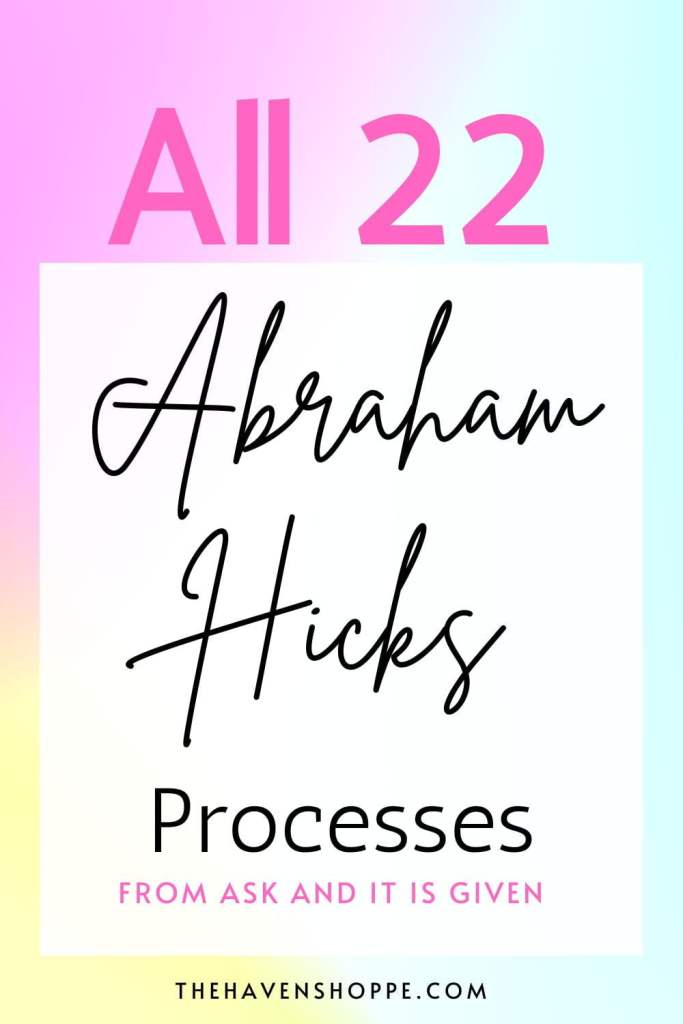
Self-care starts here!
Subscribe and I’ll send you a FREE 1-card reading every month. Plus, positive affirmations, moon cycle dates, and self-care tips to help you align with the energy of the season.💖
The Haven Shoppe LLC proudly participates in Amazon and Share A Sale affiliate programs. This means I may receive a small commission, at no cost to you, when you buy a product from this page. Thank you for supporting my small business!
Sources:



How kind of you to put this together. Its very helpful.
Thank you very much!
Cheers
Patrice
Hi Patrice, I’m so glad you found this post helpful! Thank you for leaving a comment 🩵
Thank you so much!
You are most welcome! 🩵
Thank you Andrea! I truly appreciate you summarizing all of this. It’s nice to see how other people see the processes, it’s inspiring and adds up to my learning as well.
You are most welcome! Thank you so much for your sweet comment 💫
So much appreciation to you for taking the time do this very thorough list and explain all of these processes in precise detail. And most importantly, you gave visual and written EXAMPLES of what we might write or actually do (ex. Book of Positive Aspects). So many people and websites re-explain these processes and describe them in great detail–which we can already get from “Ask and It is Given” but precious few gives us actual examples. For instance, we can listen to infinite youtube clips of Abraham describe the Book of Positive aspects, but very few human people provide a visual example of how to actually write on a topic – i.e. what might a page in my Book actually look like. Most of us already know how to do it but want some confirmation that we are doing it correctly. You have provided this confirmation. MANY MANY MANY thanks and MUCH MUCH MUCH appreciation.
You are very welcome, Raymond! I’m so glad you found the examples helpful!